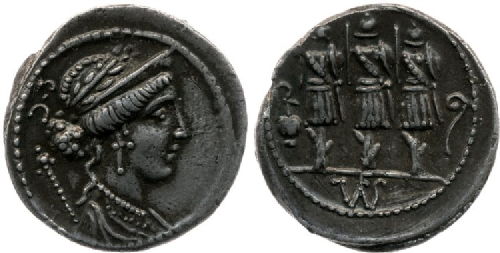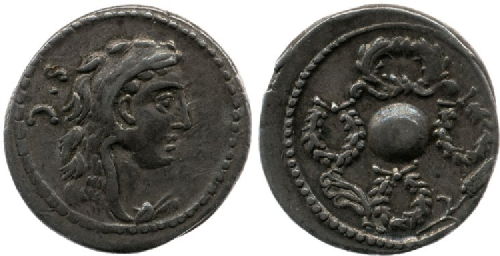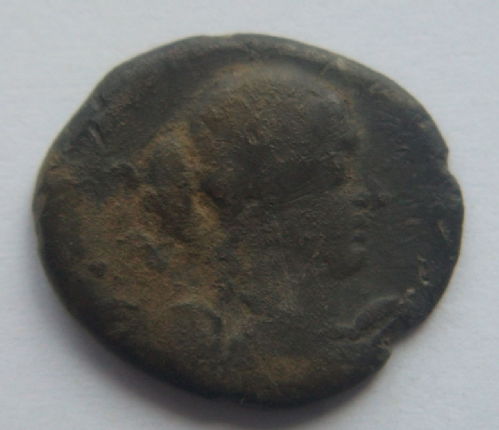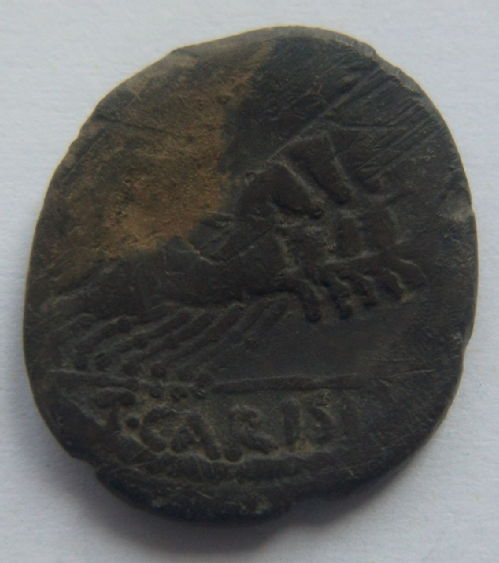All 2 entries tagged Republican Coinage
No other Warwick Blogs use the tag Republican Coinage on entries | View entries tagged Republican Coinage at Technorati | There are no images tagged Republican Coinage on this blog
July 01, 2017
Who gets the glory? Marius, Sulla, and the defeat of Jugurtha (RRC 426/1)
|
|
Roman Republican Denarius, 56 BC, RRC 426/1
Obverse: FAVSTVS. Bust of Diana right, draped and wearing diadem; above, crescent; behind, lituus. Border of dots.
Reverse: FELIX. Sulla seated left; on left, Bocchus kneeling and holding olive-branch in right hand; on right, Jugurtha kneeling with hands tied behind back. Border of dots.
This month’s coin is an issue of 56 BC, but the story which lies behind it, represented on its obverse, takes us back to the latter years of the second century BC and Rome’s war against the Numidian prince Jugurtha.
Following the death of King Micipsa in 118 BC, the kingdom of Numidia was divided between the brothers Hiempsal, Adherbal, and Jugurtha. Jugurtha had Hiempsal assassinated, and later, in 112 BC, besieged Adherbal in Cirta. Jugurtha managed to take the town and kill Adherbal, but there were also many casualties among the population of resident Italian businessmen. The Romans, who had been involved all along as mediators and interested observers, wanted vengeance for the deaths of the Italians. The war which then began proved difficult to win; politicians at Rome made accusations of incompetence and corruption against the aristocratic generals who were conducting the war.
In 107 BC, the new consul Gaius Marius took over the command. Marius was both an excellent soldier and an outsider in Roman politics with no consular ancestors. The young quaestor who accompanied him, Lucius Cornelius Sulla, was just the opposite: a descendant of an old but impoverished noble family. The sources tell us that Sulla was ambitious and was looking for an opportunity to perform some memorable exploit which would help him in his political career at Rome (Plutarch, Sulla 3). His friendship with the king of Mauretania, Bocchus I, provided the opportunity. Bocchus was the father-in-law of Jugurtha, but was hesitant about which side to support in the war. When Jugurtha lost most of his army and fled to him, Bocchus gave him shelter, but considered handing him over to the Romans. Sulla travelled to the region and organised a meeting with Bocchus, during which he convinced him to betray Jugurtha to him in a planned ambush (Sallust, Jugurthine War 111). The ambush went ahead and Bocchus surrendered the bound Jugurtha to Sulla.
This is what is represented on our coin. On the left, Bocchus is kneeling and holding out an olive branch to the central figure of Sulla, who is seated. On the right, the bound Jugurtha kneels in submission. Why was this scene so important that it was represented on a coin more than fifty years later?
Jugurtha’s capture sparked a competition between Marius and Sulla for the glory of having brought the war to an end. Moreover, the ancient sources point to this incident as the beginning of the personal enmity which led eventually to the disastrous civil war between Marius and Sulla in the 80s BC (Plutarch, Marius 10).
Marius, as the overarching commander, was awarded a triumph for finishing the war against Jugurtha. The triumph was especially noteworthy and magnificent as Marius celebrated it on the first day of his new consulship in 104 BC. He had been elected with popular support and in contravention of the law forbidding successive consulships so that he could lead the war against the Germanic tribes who were migrating across northern Italy. Marius’ glory in this moment was matched by his arrogance; after finishing the triumph with the concluding sacrifices in the temple of Jupiter Capitolinus, he convened the senate still wearing the purple triumphal garb, rather than the senatorial toga. The senators were horrified at this authoritarian gesture, and Marius changed his clothing before continuing to preside over the session.
Marius memorialised his victory by setting up a trophy. Later, after his victory over the Germanic tribes, the Cimbri and Teutones, he set up another commemorative trophy. The city of Rome itself became a witness to the victories and glory of Marius. This accorded with the usual republican practice of glorifying military successes, and especially the general under whose leadership they had been achieved.
But Sulla was not content with this. He made a rival claim to the glory of this campaign. He had the scene of Jugurtha’s submission depicted on his seal ring, so that in any correspondence with him the recipient would be reminded that this was the event which ended the war and defined his career (Plutarch, Sulla 3).
Bocchus himself also intensified the situation in 91 BC by setting up a statue group on the Capitol which depicted him handing over Jugurtha to Sulla (Plutarch, Sulla 6). The iconography of our coin likely reflects the design of this monument. Marius was greatly annoyed at both Bocchus and Sulla over the perceived challenge to his military reputation, but the Social War broke out around the same time, and the issue was left unresolved.
Marius died during the civil wars, and Sulla eventually captured Rome and instituted a bloody dictatorship, marked by proscription – the state-sanctioned murder of a set list of individuals. After his period of sole rule, Sulla resigned his power and retired to his villa, where he spent his time composing his memoirs. He died only a year later.
Despite the deaths of both Sulla and Marius, the issue of their respective reputations, including the debate over who was responsible for the end of the Jugurthine war, remained potent. During his aedileship in 65 BC, the young Julius Caesar, a nephew of Marius, concocted a bold plan: overnight, he had all of the trophies and statues of Marius which had been removed in the civil wars restored to their former places (Plutarch, Caesar 6). Regardless of whether the trophies were the originals or replicas, they suddenly brought back into the city’s public space the memory of Marius’ great campaigns. Caesar had already begun rehabilitating Marius’ memory a few years earlier, when he had given a public funeral for his aunt Julia, Marius’ widow. During the funerary procession, the images of Marius were displayed for the first time since his death.
Twenty years later, Sulla’s son Faustus reiterated his family’s claim to the glory of Jugurtha’s capture by depicting it on this coin. The coin issue was part of a series of four which celebrated both the achievements of Faustus’ father Sulla and those of his soon-to-be father-in-law Gnaeus Pompeius Magnus. On this coin, type 1 in the series, the victory over Jugurtha is paired with an image of Diana, one of Sulla’s patron deities. On the other types, Hercules and Venus also feature prominently, while the names Faustus and Felix (an honorific name for Sulla) are themselves a reminder of the special divine favour which Sulla claimed to enjoy. Types 3 and 4 refer to Pompey and bring him into this conversation about glory and divine favour. The reverse of type 3 (RRC 426/3, below) shows the three trophies which were the emblem on Pompey’s signet ring, while the reverse of type 4 (RRC 426/4, below) shows the globe, four wreaths, and an ear of corn; all are references to the magnificent achievements of Pompey in ridding the Mediterranean of pirates, celebrating three triumphs over three continents, and ensuring the Roman grain supply through his special commission. The joining of Sulla and Pompey in this multi-layered iconography of victory and divine favour is fitting, as it was Sulla who had essentially given Pompey his political start. Pompey’s first great action was raising an army of his father’s veteran soldiers to fight for Sulla in the civil war.
 |
 |
| RRC 426/3 | RRC 426/4 |
Why did the question of who was responsible for the capture of Jugurtha matter so much not only to Marius and Sulla, but also to the next generation? Roman politics was intensely competitive, with individuals striving against each other for opportunities to serve the state. If one could demonstrate that one’s ancestors had already served the state gloriously, this was one way to gain prestige and a better chance of election. The memories and monuments of past successes mattered so much to Roman politicians because their lives were defined by the competition for glory, praise, and honours. These had to be publicly bestowed and commemorated. Politicians would remind the Roman people of their ancestor’s achievements in the hopes that they too would be allowed to serve the state and achieve glory. It was a competition for symbolic capital which consistently, though not exclusively, returned the members of the same few families to the highest magistracies.
 |
This month's entry was written by Dr. Hannah Mitchell. Hannah specialises in the political culture of the late republic and Augustan periods. She is writing a book on political careers and aristocratic self-presentation during the civil wars of the 40s and 30s BC.
Coin images reproduced courtesy of the British Museum (©The Trustees of the British Museum).
Bibliography
Flower, H. 2006. The Art of Forgetting: Disgrace and Oblivion in Roman Political Culture, Chapel Hill.
Harlan, M. 2015 (2nd edn). Roman Republican Moneyers and their Coins, 63 BC – 49 BC, London.
Mackay, C.S. 2000. ‘Sulla and the Monuments: Studies in his Public Persona’, Historia 49.2, 161-210.
May 01, 2015
In the shadow of a dictator
 |
 |
Coin of Titus Carisius
Obverse: Victoria right, SC behind. Reverse: Victory driving a Quadriga, T.CARISI in exergue (Sydenham 985, Crawford 464/5)
If one were to poll 100 individuals about the name ‘Titus Carisius’, all 100 would be forgiven for having never heard of him. His appearance in the Roman Republican monetary record is simply overshadowed by the folklore popularity of contemporary figures such as Pompey the Great and Julius Caesar. Even Roman historians only briefly record the exploits of the gens Carisia, the lineage from which Titus descends. Cassius Dio refers to a ‘Titus Carisius’, presumably the same individual as our moneyer, defeating the native Astures in the province of Hispania and founding a colonia there (Dio LIII.25.8). However, the later historian Florus records the same feat of 25BC as the exploits of a legate with the praenomen ‘Publius’ not ‘Titus’ (Epitome II.33; Florus lived from c. 70 – 140 AD). It would appear from the subsequent coinage of the new colonia founded for the Legio V Alaudae and Legio X Gemina that Florus was correct in his documentation as coin legends clearly record P. CARISI as the legate and pro-praetor. Such confusion therefore compounds the disappearance of Titus Carisius from history. This article seeks to re-establish this forgotten triumvir monetalis of 46 BC alongside the recognizable names of the period, by evaluating one example from the fascinating series of coins he produced.
The actual coin used in this article is a recent discovery from Britain that has inspired this piece. At first glance it would appear to most as an ordinary example of Republican coinage, displaying the personification of a goddess on the obverse with a symbol of Republican Rome on the reverse. In this case it depicts a quadriga (4-horse chariot); a symbol used on the earliest denarii of 211 BC. This traditional symbol twinned with a goddess here would not look out of place amongst those late 3rd century BC issues, were it not for the goddess depicted on our coin. The personification of Victoria with the legend S.C adorns the coin’s obverse, a symbolization therefore of a victory commemoration.
History does not record a triumph of the gens Carisia in 46 BC when this coin was struck, nor is there a documented history of the Carisian line before the mid 1st century BC. So it is unlikely this coin issue commemorates a family victory. It must therefore herald the victory of a contemporary event or figure - Julius Caesar. Such a conclusion should not be remarkable, considering Caesar had just been declared a dictator for ten years. He was therefore well-known, holding a position of direct and indirect influence over the coinage minted. Another known type of Titus Carisius depicts a cornucopia above a globe with a sceptre and rudder on either side (Crawford 464/3A). Such imagery evokes ideas of wealth and prosperity over the globe, with the rudder acting as a guide. This is comparable with Caesar’s accomplishments in annexing Gaul and forays to Britain in the previous decade.
Furthermore, connections between the quadriga-issue and a Caesarian triumph can be identified when Caesar’s own coin types are considered. It is widely accepted that Caesar continued his own coin production from his moving Spanish mint in 46 BC, striking types that reference his victory in the bello gallico of 58-50 BC (See RSC 13; Sydenham 1014; Crawford 468/1). Further links between the two can be found from an inscription (Figure 1) discovered in Avignon in 1841 believed to date from the third quarter of the 1st century BC (see Christol, M: Une nouvelle dédicace de T(itus) Carisius, praetor Volcarum, près d'Ugernum (Beaucaire, Gard) 2005 for more information). It briefly records a “Titus Carisius, son of Titus, Praetor of the Volcarum”, leading to speculation that Titus may have been the son of a soldier of the Volques tribe of Southern Gaul, granted Roman citizenship during Caesar’s time. This offers a potential explanation for a lack of records for a gens Carisia prior to the 1st century BC and even circumstantial evidence of historical connections between a character likely to be our moneyer and Caesar. Therefore it is by no means a stretch of the imagination to compare their coinages.

Figure 1: Avignon Inscription (Wikimedia Commons)
The reverse of our coin has similar Republican-themed imagery, with an unmistakable figure driving a quadriga with T.CARISI beneath in the exergue. Once more the personification of Victory appears, again suggesting that this coin’s message of victory is too forceful to be unintentional – hinting at the fusion of existing Republican iconography with contemporary Caesarian ideology. On reflection, this may provide the ultimate reason why ‘Titus Carisius’ has been virtually erased from history. The fact this coin type is so similar to many other Republican issues, as well as being loaded with Caesarian propaganda, aided Carisius’ disappearance. However one factor remains that explains how I am able to write such an article upon Carisius’ coinage - his name. The very fact that Titus Carisius ascribed his own coinage, a standard practice among Republican moneyers, gives us a small window into the dying days of the Republic, a time clearly dominated by the actions of one man and his heirs. Yet this coin offers more; it provides insight into the actions and presumably the aspirations of other forgotten members of the ruling classes. Does this coin, however subtly clouded in Caesarian propaganda, radiate a hope for the restoration of earlier Republican values by utilizing an established coin design, or does it simply confirm the acceptance of a dictator? However likely the latter is from the available evidence, the true meanings of the coin have unfortunately been lost to the passage of time. I am however certain of one thing… I’m glad he left us his name.
 Written by Gregory Edmund, currently a 2nd Year Undergraduate studying Ancient History at the University of Warwick. His main interests lie in Republican Roman coinage (after 211BC) as well as Iron-Age and Roman Britain.
Written by Gregory Edmund, currently a 2nd Year Undergraduate studying Ancient History at the University of Warwick. His main interests lie in Republican Roman coinage (after 211BC) as well as Iron-Age and Roman Britain.

 Clare Rowan
Clare Rowan

 Please wait - comments are loading
Please wait - comments are loading

 Loading…
Loading…

